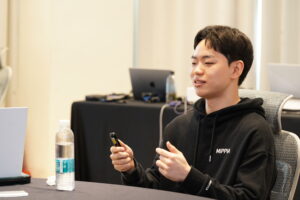“When I grow up, I want to be a STEM teacher!”
These were not the words that came out of my mouth when I was 5 years old. I always dreamed of being a teacher, but being a STEM teacher was not in the plan. STEM wasn’t even a thing when I was a little kid!
My dreams eventually came true, and I landed a role teaching 2nd grade. Fast forward to me teaching in the classroom for six years (2nd and 3rd grade) and then landing a position teaching K-5 STEM.
I was granted a brand new classroom with limited supplies and zero curriculum. I didn’t know a soul in the building. My role was to teach innovative lessons to all the 500+ children in the school, manage school-wide technology, and co-teach with the teachers in my building- such an easy feat, right?
As lessons were developed and supplies collected, the students became fascinated by what STEM could be in their elementary world. We coded robots, built prototypes from recycled materials, and even took our learning outside with my unique unit, STEM Survival Camp.
Through my years teaching K-5 STEM, I realized that this opportunity for students was less about the tools. Rather, it was more about the life skills that children were developing during their time with me.
I even told my students this. So what does STEM education teach our students? Here’s my take.
Resilience
We think not giving up when things are hard is an innate skill. It’s not. I don’t have enough fingers to count the number of times kids cried when a piece of their project didn’t work the first time, and they wanted to give up.
We need to provide our students with countless opportunities to try and fail multiple times. Not only that but being able to try and fail with different mediums is essential. Some students excel at 3D print design but get frustrated when building with cardboard. Students need to face challenges, learn how to overcome them, and understand that not everything will be easy. That’s ok! Life isn’t easy, and we need kids who can persist, even when a challenge doesn’t work or it’s hard.
Collaboration
As students became accustomed to my class, we thrived in the collaboration department. For projects, students held various roles when solving a problem. For example, with LEGO building, we would have a “Builder,” a “Finder,” and a “Director.” While it was a process, students were grasping the skill of collaborating.
Then the pandemic happened. When we returned to in-person teaching, a lot shocked me, but the collaboration piece surprised me the most. I used to have comfortable classmates asking one another for solutions, and I was the guide throughout the process. In contrast, students were highly dependent on me. They hardly thought to ask the person sitting next to them who was working on the same project.
We often take for granted how important human connection is, but the skill of collaboration is one that even impacts elementary-aged children and is something we have to continue to work on.
Creativity
Kindergarteners, especially, were my most creative group of students year after year. They are so proud of the ideas they come up with, even if it wasn’t feasible. Everyone has a spark of creativity in their own unique way. Some students are excellent storytellers.
I had one student working on our LEGO builds who loved to add in The People (mini figures), give them names, and create a whole scene for them. Another student, who reminded me of a Disney Imagineer, added immense detail to our makerspace challenges when we combined robotics. Likewise, I had another student who added fun jokes and music to their coding stories.
The world needs multiple perspectives when thinking of the world in new ways. STEM brings out those inner passions in students and helps them apply their creativity in new situations.
Empathy
I hardly hear the phrase often used by students, “Why do we have to learn this?” in my STEM classroom. Why? As the teacher, I would ask them that exact question: What is the point of doing any of this?
I was working on a 3D printing project with 5th graders, an age that can sometimes be hard to connect with, and we were talking about Earth’s resources. From there, we discussed different types of depleted natural resources and various issues that are facing our environment.
Important, yes, but I wanted students to understand the impact as to why our choices as humans, good or bad, make a difference. By shifting this perspective, students were more passionate about their final design and why it was impactful to make a change. Having students see outside of themselves and having compassion for others through design can connect their learning to a bigger purpose.
While there is a large push to include STEM and innovative classes starting in middle and high school, how are we reaching our youngest learners? Not only do our students need to have the experience using current tools, but also unique opportunities to practice soft skills. While these skills can still be worked on in a traditional classroom setting, adding an element of hands-on learning and innovation can add a new and challenging perspective.
When asking why elementary children need a STEM class, consider the opportunities less about the cute robot and more about the skills that students need to succeed for today and their futures.











